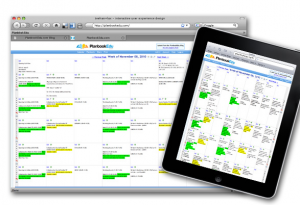No-Fear Planning for Co-Teachers
A MiddleWeb Blog
It seems to me that co-planning could make the top 10 list of co-teaching woes for too many.
For teachers who have administrative support and open-minded, flexible co-teachers, life is good. No, actually, it’s great! Through my years as a co-teacher, I’ve experienced this exhilarating emotion of intentional co-teaching. It’s the kind of teaching that happens when the two teachers in the room plan ahead — together.
Oh, how I love this proactive approach. I often imagine how powerful co-teaching would be if most (dare I say all?) co-teachers would plan in a way that allows for each other’s strengths to help the kids really shine.
Laurie’s last post got me thinking about what my ideal co-planning experience would be like. Here’s what I envision solid intentional co-planning time to look like.
The special educator would :
• Plan to meet the individual needs by aligning the IEP goals to the lesson objectives and standards
• Plan for specific program modifications (could be special seating arrangements, graphic organizer, additional visual or verbal cues, etc.)
• Discuss possible strategies to further support the instructional process
• Know the material
• Create a plan for monitoring student progress
The general educator would:
• Keep the curriculum flowing by sharing what needs to be taught
• Share lesson objectives
• Share general outline and the instructional process (lesson activities)
• Discuss assessment of student performance
In addition, the teachers would plan out who will be responsible for specific parts of the lesson as well as what co-teaching model(s) (discussed in a previous post) they would use for optimal instructional time. This kind of planning allows for a flow of teaching and learning that can guide students to thrive. I imagine this kind of planning time would happen at least once a week.
This is one of the ideal models that looks good on paper, yet does not find its way into all co-teaching relationships. One year you have this meaningful planning experience and the next year your co-teaching partnership changes, and you find yourself struggling to strike that same balance. So, basically from year to year, you never know what experience you’re going to get.
Why can’t intentional co-teaching happen all (not most, but all) of the time?
The only answer I come up with is…human nature. People have to want to make it work. And not everyone will work through the snafus that arise to make it happen. So rather than keeping co-planning on my top 10 list of co-teaching woes, here are a few simple mindshifts I’ve decided to stick with.
1. I’ll remain resourceful
Rather than wasting my energy on wishing for and trying to make consistent and meaningful common planning time (it just won’t exist, for a variety of reasons), I take and make what time I can get.
My focus becomes completely on the reality of my position. So, with one teacher, I make a copy of her week’s lessons and add my part on my own time. Then I share with her the next day or so. We end up putting the lesson together as the moments of teaching unfold. I jot down anecdotal notes during the lessons regarding student participation and performance, so I know what follow-up will be needed.

Without this common planning time and mutual desire to make the time, I work hard to re-channel my energy from feeling exceptionally frustrated to remaining resourceful. I make sure to get my co-teacher’s general topics and general lesson idea for each day. I spend my personal planning time thinking about possible strategies and accommodations that I can insert on any given day. This approach is not foolproof, but it keeps me striving to search for viable resources around me.
In addition, it keeps me determined to make sure I do my part to guide the students toward success. This keeps me focused on an action plan—rather than a tale of woe.
2. I’ll remain in the moment(s)
Needless amounts of wasted energy can be spent on feeling frustrated about insufficient co-planning time or less than perfect co-teaching partnerships. But it is important to stay in the moments.
During lessons that are not co-planned to my hopeful expectations, I relax and go with the flow of what effective teachers must do. I stay observant to my co-teacher’s moves. I watch, I listen, and I understand the individual needs of all students in the class, at that time and during that lesson. This relaxed frame of mind allows me to make the most of the class time. Rather than feeling frustrated, I enjoy the moments of the class and think about how I can join my co-teacher’s efforts and somehow strengthen the learning process.
This mindset inevitably leads me to think about strategies and accommodations that could work for future lessons—hopefully making that “jump-in” teaching mindset easier. Remaining in the moments has done wonders for me.
3. I’ll keep an accurate lesson plan book
Technology to the rescue here. One of the hardest parts for me has been keeping my planbook accurate and organized. You see, I’ve experienced co-teachers who do not always keep a planbook of their own.
Or, you write out your plan — and your co-teacher needs to change the plan at the very last minute. When co-teaching, let’s face it, one teacher’s planbook depends on the other teacher’s. Or so you would think. I’ve found that the most effective way to keep my plans accurate is when I use technology.
Here’s one example, I often use SmartBoard technology. One of my colleagues gave me the idea to just print out the slides and tape it right in to my planbook. Brilliant! It really works to keep me organized.

A third option is the use of Google Docs. In school many of us encourage students to use this tool in their collaborative work with peers. So why not use it to guide collaboration between co-teachers?
4. I’ll remember there is nothing to fear
Special and general educators are no stranger to this uncomfortable emotion of fear. So many teachers fear change — and it is understandable to know that when you are co-teaching, certain changes must be in place.
Typically, general education teachers may fear having another teacher in the room — or fear losing control over territory. They may fear how a second teacher will judge or change their teaching behaviors. One teacher I worked with years ago told me she feared that the kids would like me better than they liked her.
Special education teachers may fear the unknown. Since we are spread over a variety of grade levels and content areas, it can be daunting to be expected to know everything about all subjects and all grade levels. Special education teachers may also feel the pressure of finding those “just right” ways to accommodate students’ needs and guide them toward independent learning.
Yet, I have found my fear-nothing mindset to work like a charm.
We all have a job to do — and so we do it. We can stay resourceful, enjoy the “in the moments” of teaching, organize our lesson plans, remember to smile and laugh, and above all fear nothing. If we “fear nothing,” we can enjoy, relax, and learn from everything and everyone around us. And really, the students deserve nothing less from us!
Laurie and I are looking forward to hearing your thoughts about the in’s and out’s of co-planning. Let’s chat…
































As I was working on my planbook, I realize I need to make a correction with my description of the planbookedu.com features. If using planbook.edu at the basic level, itl is free of charge. It offers the ability to easily apply common core standards.
However, in order to attach files,export plans to a pdf , and print, you must update to the premium level (I think it’s worth it!). There is a fee for the year at this premium level, but I think it’s a reasonable, and the program offers great options.
There is a free trial period of 14 days where you can experience the good life at the premium level free for 14 days. After the 14 days, you will be back to the basic level (life is great there, too).
In either the basic or the premium level, your lessons are saved to your account, and they can be accessed online anytime. Check it out and see for yourself–enjoy!
Anyone using this–or interested in checking it out? Do share!
I love planbookedu! I’ve been using it since. October and love the ability to share with my coteacher. I also use a livebinder to keep all my electronic resources organized.